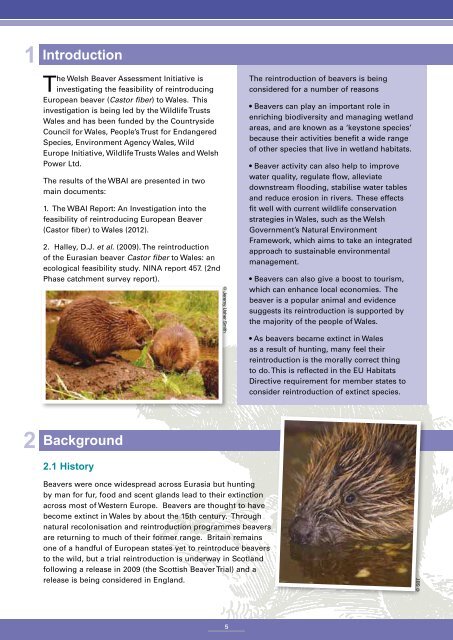Beaver-Summary-report-English
Beaver-Summary-report-English
Beaver-Summary-report-English
You also want an ePaper? Increase the reach of your titles
YUMPU automatically turns print PDFs into web optimized ePapers that Google loves.
1<br />
2<br />
Introduction<br />
The Welsh <strong>Beaver</strong> Assessment Initiative is<br />
investigating the feasibility of reintroducing<br />
European beaver (Castor fiber) to Wales. This<br />
investigation is being led by the Wildlife Trusts<br />
Wales and has been funded by the Countryside<br />
Council for Wales, People’s Trust for Endangered<br />
Species, Environment Agency Wales, Wild<br />
Europe Initiative, Wildlife Trusts Wales and Welsh<br />
Power Ltd.<br />
The results of the WBAI are presented in two<br />
main documents:<br />
1. The WBAI Report: An Investigation into the<br />
feasibility of reintroducing European <strong>Beaver</strong><br />
(Castor fiber) to Wales (2012).<br />
2. Halley, D.J. et al. (2009). The reintroduction<br />
of the Eurasian beaver Castor fiber to Wales: an<br />
ecological feasibility study. NINA <strong>report</strong> 457. (2nd<br />
Phase catchment survey <strong>report</strong>).<br />
Background<br />
2.1 History<br />
<strong>Beaver</strong>s were once widespread across Eurasia but hunting<br />
by man for fur, food and scent glands lead to their extinction<br />
across most of Western Europe. <strong>Beaver</strong>s are thought to have<br />
become extinct in Wales by about the 15th century. Through<br />
natural recolonisation and reintroduction programmes beavers<br />
are returning to much of their former range. Britain remains<br />
one of a handful of European states yet to reintroduce beavers<br />
to the wild, but a trial reintroduction is underway in Scotland<br />
following a release in 2009 (the Scottish <strong>Beaver</strong> Trial) and a<br />
release is being considered in England.<br />
© Jeremy Usher Smith<br />
5<br />
WELSH BEAVER ASSESSMENT INITIATIVE - SUMMARY REPORT<br />
The reintroduction of beavers is being<br />
considered for a number of reasons<br />
• <strong>Beaver</strong>s can play an important role in<br />
enriching biodiversity and managing wetland<br />
areas, and are known as a ‘keystone species’<br />
because their activities benefit a wide range<br />
of other species that live in wetland habitats.<br />
• <strong>Beaver</strong> activity can also help to improve<br />
water quality, regulate flow, alleviate<br />
downstream flooding, stabilise water tables<br />
and reduce erosion in rivers. These effects<br />
fit well with current wildlife conservation<br />
strategies in Wales, such as the Welsh<br />
Government’s Natural Environment<br />
Framework, which aims to take an integrated<br />
approach to sustainable environmental<br />
management.<br />
• <strong>Beaver</strong>s can also give a boost to tourism,<br />
which can enhance local economies. The<br />
beaver is a popular animal and evidence<br />
suggests its reintroduction is supported by<br />
the majority of the people of Wales.<br />
• As beavers became extinct in Wales<br />
as a result of hunting, many feel their<br />
reintroduction is the morally correct thing<br />
to do. This is reflected in the EU Habitats<br />
Directive requirement for member states to<br />
consider reintroduction of extinct species.<br />
© SBT


